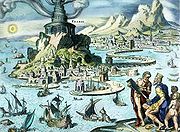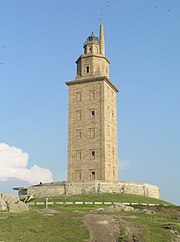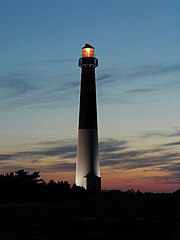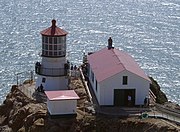A lighthouse is a tower, building or, framework designed to emit light from a system of lamps and lenses or, in older times, from a fire and used as an aid to navigation and to pilots at sea. Lighthouses are used to mark dangerous coastlines, hazardous shoals, safe entries to harbors and can also assist in aerial navigation. Once widely used, the number of operational lighthouses has declined due to replacement by modern electronic navigational aids.
Lighthouse technology
In a lighthouse, the source of light is called the "lamp" (whether electric or fueled by oil) and the magnification of the light is caused by the "lens" or "optic".
Originally lit by open fires and later candles, the Argand hollow wick lamp and parabolic reflector was developed around 1781 in Europe. In the US, whale oil was used with solid wicks as the source of light until the Argand parabolic reflector system was introduced around 1810 by Winslow Lewis.

Cutaway fixed Fresnel Lens of
Loschen-lighthouse,
Bremerhaven [1] Colza oil replaced whale oil in the early 1850s, but US farmers' lack of interest in growing this caused the service to switch to lard oil in the mid 1850s. Kerosene started replacing lard oil in the 1870s and the service was finally totally converted by the late 1880s. Electricity and carbide (acetylene gas) started to replace kerosene around the turn of the century. [2]
Lens technology
Prior to modern strobe lights, lenses were used to concentrate the light from a continuous source. Two tasks were involved:
- vertical light rays of the lamp are redirected into a horizontal plane
- horizontally the light is focused into one or a few directions at a time, with the light beam sweeping around; as a result, in addition to seeing the side of light beam, there are instants that one can see the light directly from a further distance away.
Fresnel lens
This concentration of light is accomplished with a rotating lens assembly. In classical period lighthouses, the light source was a kerosene lamp, and the lenses were rotated by a weight driven clockwork assembly wound by lighthouse keepers, sometimes as often as every two hours. The lens assembly usually floated in mercury to reduce friction. In more modern lighthouses, electric lights and motor drives were used, generally powered by diesel electric generators. These also supplied electricity for the lighthouse keepers.[3] Efficiently concentrating the light from an omnidirectional light source requires a lens of very large diameter. This would require a very thick and heavy lens if naively implemented. The development of the Fresnel lens (pronounced FREH nel) in 1822 revolutionized lighthouses in the 1800s, focusing 85% of a lamps light versus the 20% focused with the parabolic reflectors of the time. Its design enabled the construction of lenses of large size and short focal length without the weight and volume of material in a lens of conventional design. Although the Fresnel lens was invented in 1822, it wasn’t used in the US until the 1850s due to the parsimonious administrator of the United States Lighthouse Establishment, Stephen Pleasonton. With the creation of the United States Lighthouse Board in 1852, all U. S. lighthouses received Fresnel lenses by 1860. [4]
Fresnel lens order of magnitude
Fresnel lenses were ranked by Order, with a first order lens being the largest, most powerful and expensive; and a sixth order lens being the smallest. The order is based on the focal length of the lens. A first order lens has the longest focal length, with the sixth being the smallest. Coastal lighthouses generally had first, second or third order lenses, while harbor lights and beacons had fourth, fifth or sixth order lenses.[5]
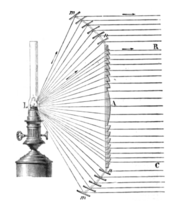
How a Fresnel lens works.
Some lighthouses, such as those at Cape Race, Newfoundland, and Makapu'u Point, Hawaii, used an even more powerful hyperradiant Fresnel lens manufactured by the firm of Chance Brothers.
In recent decades, many Fresnel lenses have been replaced by rotating aerodrome beacons which require less maintenance. In modern automated lighthouses this system of rotating lenses is often replaced by a high intensity light that emits brief omnidirectional flashes (concentrating the light in time rather than direction). These lights are similar to the obstruction lights used to warn aircraft away from tall structures. More recent innovations are "Vega Lights" and initial experiments with LED panels [6]
Light characteristics
In any of these designs an observer, rather than seeing a continuous weak light, sees a brighter light during short time intervals. These instants of bright light are arranged to create a light characteristic or, pattern specific to the particular lighthouse. [7] For example, for the lighthouse of Scheveningen the time intervals between these instants are alternately 2.5 and 7.5 seconds.
To assist in distinguishing between lighthouses, the time interval of the light or the color pattern of the lens is varied. Sector lights may additionally have a red or green filter on parts of the lantern house to distinguish safe water areas from dangerous shoals.
Modern lighthouses often have unique reflectors or Racon transponders so the radar signature of the light is also unique. [8]
Building
Building design

The lighthouses in
Finland as of the year 1909, showing differing architecture.
To be effective the lamp needs to be high enough to be seen before the danger is reached by a mariner. The necessary height is calculated by taking the square root of the height of a light in feet and multiplying it by 1.17, yielding the distance to the horizon in nautical miles.[9]
Where dangerous shoals are located far off a flat sandy beach, the prototypical tall masonry coastal lighthouse is constructed to assist the navigator making a landfall after an ocean crossing. Often these are cylindrical to reduce the effect of wind on a tall structure on less stable soil. An example of this style is Cape May Lighthouse. Smaller versions of this design are often used as harbor lights to mark the entrance into a harbor, such as New London Harbor Light.
Where a tall cliff exists, a smaller structure may be placed atop it as the location is already high above the water, such as at Horton Point Light. Sometimes, such a location can actually be too high as along the west coast of the United States. In these cases, the lights are often placed below the top of the cliff to ensure that they can still be seen at the surface during periods of fog. An example of this is Point Reyes Lighthouse. Another victim of fog was Point Loma Light (old) which had to be replaced with a lower light, Point Loma Light (new).
As technology advanced, prefabricated skeletal iron or steel light houses tended to be used for lighthouses constructed in the twentieth century. These often have a narrow cylindrical core surrounded by an open lattice work bracing, such as Finns Point Range Light.
Sometimes a lighthouse needs to be constructed in the water itself. Wave washed lights are masonry structures constructed to withstand water impact, such as Eddystone Lighthouse in Britain and the St. George Reef Light off California. In shallower bays, screw pile ironwork structures are screwed into the seabed and a low wooden structure is placed above the open framework, such as Thomas Point Shoal Light. As screw piles can be disrupted by ice, in northern climates steel caisson lighthouses such as Orient Point Light are used. Orient Long Beach Bar Light (Bug Light) is an interesting blend of a screw pile light that was later converted to a caisson light because of the threat of ice damage. [10]
In waters too deep for a conventional structure, a lightship might be used instead of a lighthouse. Most of these have now been replaced by fixed light platforms (such as Ambrose Light) similar to those used for offshore oil exploration.[11]
Building components
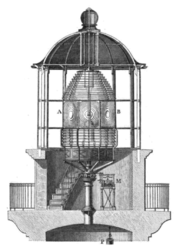
Lighthouse lantern room from mid 1800s.
While the buildings differ depending on the lights location and purpose, they tend to share the following components.
A Light Station consists of the Lighthouse tower and all of the outbuildings, i.e. the keeper¹s living quarters, fuelhouse, boathouse, fog-signaling building, etc. The Lighthouse itself consists of a tower structure supporting the lantern room were the light operates.
The Lantern Room is the glassed-in housing at the top of a lighthouse tower containing the lamp and lens. Its glass storm panes are supported by metal Astragal bars running vertically or diagonally. At the top of the lantern room is a stormproof Ventilator designed to remove the smoke of the lamps and the daytime heat that builds up in such a glass enclosure. A Lightning rod and grounding system is usually connected to the metal Cupola roof to provide a safe conduit for any lightning strikes.
Immediately beneath the lantern room is usually a Watch Room or Service Room where fuel and other supplies were kept and where the keeper prepared the lanterns for the night and often stood watch. The clockworks (for rotating the lenses) were also located there. On a lighthouse tower, an open platform called the gallery is often located outside the watchroom (called the Main Gallery) and/or Lantern Room (Lantern Gallery.) This was mainly used for cleaning the outside of the windows of the Lantern Room.[12]
Lights near to each other that are similar in shape are often painted in a unique pattern so they can easily be recognized during the daylight. This marking is called a daymark. The black and white spiral pattern of Cape Hatteras Lighthouse is an example of this. The only stone lighthouse in Western Canada, constructed in 1860 by the British at Race Rocks is now a significant historic sight in the Race Rocks Marine Protected Area It was painted in horizontal black and white bands in order to stand out against the horizon.
History
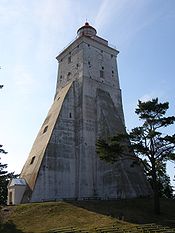
Kõpu lighthouse in Estonia, the third oldest operating lighthouse in the world
Ancient
Perhaps the most famous lighthouse in history is the Lighthouse of Alexandria, built on the island of Pharos in Hellenistic Egypt. The name of the island of Pharos is still used as the noun for "lighthouse" in some languages, for example: Albanian and Catalan and Romanian (far), French (phare), Italian and Spanish (faro), Portuguese (farol), Swedish (fyr), Bulgarian (фар), and Greek (φάρος). The word "pharology" (study of the lighthouses) is also derived from the island's name. [13]
The Lighthouse of Alexandria was originally built in 280 BC to serve as that port's landmark. With a height variously estimated at between 115 and 135 metres (383 - 440 ft) it was among the tallest man-made structures on Earth for many centuries, and was identified as one of the Seven Wonders of the World by classical writers. Two lighthouses, each called the Pharos, were built at Dover soon after the Roman conquest of Britain. They were sited on the two heights (Eastern Heights and Western Heights) and modelled on the one built for Caligula's aborted invasion at Boulogne. [14]
In the Islamic world, lighthouses were also known. The Tang Dynasty Chinese writer Jia Dan once wrote in his book (written between 785 - 805) that in the sea route forming the opening mouth of the Persian Gulf, the medieval Iranians had erected large minaret towers that served as lighthouses. Confirming the Chinese reports, a century later, the Arab writers al-Mas'udi and al-Muqaddasi wrote of the same lighthouses.[15]
In China, the medieval mosque at Canton had a minaret that served as a lighthouse. The later Song Dynasty Chinese pagoda tower built in medieval Hangzhou, known as the Liuhe Pagoda (erected in 1165), also served as a lighthouse for sailors along the Qiantang River.
During the Dark Ages, Roman lighthouses fell in disuse but some still remained in use, such as the Tower of Hercules in A Coruña, Spain, and others mainly in the Mediterranean Sea. As navigation improved, lighthouses gradually expanded to Western and Northern Europe. [16]
Classic period
Lighthouse development accelerated in the seventeenth century with national lighthouse services established in Denmark (1650), Finland (1696) and Britain's Trinity House constructing its first in 1619. Eddystone Lighthouse was first lit in 1698. As Britain became the dominant seapower, lighthouses constructed by the Stephenson family for the Northern Lighthouse Board began to appear in Scotland. [17]
The first lighthouse in America was Boston Light on Little Brewster Island (1716). The first keeper was George Worthylake who was drowned, along with his wife and daughter, when returning to the island in 1718. The original tower was destroyed by the British during the evacuation of Boston and eventually reconstructed in 1784. The oldest existing lighthouse in America is Sandy Hook Lighthouse, NJ (1764), which is still in operation. By the end of the 19th century, the United States with its long coastlines had the most lighthouses of any nation. [18]
The US Bureau of Lighthouses was created in 1789 by the 9th Act of the first Congress which placed lighthouses under federal control. Over the years, lighthouses were placed under the direction of Department of Revenue (this department was disbanded in 1820), Department of Treasury (until 1903), then the Department of Commerce. The Lighthouse Board (of the U. S. Lighthouse Establishment) held sway from 1852 to July 1, 1910 when Commerce created the Lighthouse Service. The United States Coast Guard took over on July 7, 1939. [19]
After 1852 the country was divided into Lighthouse Districts; originally eight, they eventually numbered 19. Each District was run by a Naval Officer appointed by the Lighthouse Board as the District Inspector. He ran the district in tandem with an Army Corps of Engineers' officer who was in charge of engineering projects. In 1910, civilians started replacing the military officers. [20]
Lighthouse keepers were needed to trim the wicks, replenish fuel, wind clockworks and perform maintenance tasks such as cleaning lenses and windows. In 1907 Nils Gustaf Dalén produced the sun valve which turned the beacon on and off using daylight. The first one was erected on Furuholmen’s lighthouse between Stockholm and Vaxholm[21]. In 1912 Dalén was awarded the Nobel Prize in Physics for his invention of 'automatic valves designed to be used in combination with gas accumulators in lighthouses'[22]
Dalén's inventions, electrification and automatic lamp changers began to make lighthouse keepers obsolete. However, for many years, lighthouses still had keepers, partly because lighthouse keepers could serve as a rescue service if necessary. Improvements in maritime navigation and safety such as GPS have led to the phasing out of non-automated lighthouses, with the last keepers removed in the 1990s.[23]
Modern
Often in inaccessible locations, modern lighthouses are much more functional and less picturesque; usually they use solar-charged batteries and have a single stationary flashing light sitting on a steel skeleton tower. The last manned lighthouse built in the US was the Charleston Light constructed in 1962. Resembling an air traffic control tower, it has such modern features as a triangular shape, aluminum alloy skin, air conditioning, an elevator and the most powerful lamp in the Western Hemisphere. It too is now automated. [24]
Famous lighthouse builders
Some builders are well known for their work in building multiple lighthouses. The Stevenson family (Robert, Alan, David, Thomas, David Alan and Charles) made lighthouse building a three generation profession in Scotland. Irishman Alexander Mitchell invented and built a number of screwpile lighthouses despite being blind. Corps of Engineers Lieutenant George Meade built numerous lighthouses along the Atlantic and Gulf coasts before gaining wider fame as the winning general at the Battle of Gettysburg. Alexander Ballantyne built two of the most challenging wave washed lighthouses on barren rock in the Pacific, Tillamook Rock Light and St. George Reef Light. [25] Englishman James Douglass was knighted for his work on lighthouses
Range lights
-

Range Lights in Nantucket, MA. This view indicates that the observer is to the left of the desired channel.
Aligning two fixed points on land provides a navigator with a line of position called Range. Ranges can be used to precisely align a vessel within a narrow channel such as in a river. If the landmarks of a range are illuminated with a set of fixed lighthouses, navigation can also be done at night.
Such paired lighthouses are called Range lights. Two lights are used in this scheme. The one closer to the vessel is named the beacon or front range; the furthest away is called the rear range. The rear range light is always taller than the front range light.
When the vessel is on the correct course, the two lights line up above one another. But when the observer is on the wrong course, the difference in alignment makes it very obvious whether to travel left or right to correct the problem.[26]
Maintenance
In the United States, lighthouses are maintained by the United States Coast Guard. [27] Those in England and Wales are looked after by Trinity House, those in Scotland by the Northern Lighthouse Board, and those in Ireland by the Commissioners of Irish Lights. In Canada, they are managed by the Canadian Coast Guard. In Australia, lighthouses are looked after by the Australian Maritime Safety Authority.
The Soviet Union built a number of automated lighthouses powered by radioisotope thermoelectric generators in remote locations. They operated for very long periods of time without external support with great reliability [28]. However numerous installations have been found deteriorated, stolen and/or vandalized. Some of these lighthouses cannot be found due to poor record keeping. [29]
Preservation
As lighthouses have become less essential to navigation, many of their historic structures have faced demolition or neglect. In the United States, the Historic Lighthouse Preservation Act of 2000 [30] provides for the transfer of lighthouse structures to local governments and private non-profit groups, while the USCG continues to maintain the actual lamps and lenses. In Canada, the Nova Scotia Lighthouse Preservation Society won heritage status for Sambro Island Lighthouse and has sponsored a bill to change to Canadian federal laws to protect lighthouses.[31]
Many groups have been formed to restore and save lighthouses around the world. They include the World Lighthouse Society and the United States Lighthouse Society. Another international group is the Amateur Radio Lighthouse Society, which sends amateur radio operators to publicize the preservation of remote lighthouses throughout the world.[32]
Popular culture and symbolism
Visiting and photographing lighthouses are popular hobbies as is collecting ceramic replicas of them. In some locations, lighthouses have become popular travel destinations in themselves and the buildings are maintained as tourist attractions. In the US, National Lighthouse and Lightship Weekend is celebrated on the first weekend of August and International Lighthouse and Lightship Weekend is celebrated on the third weekend. Many lighthouses are open to the public and Amateur Radio Operators often communicate between them on these days.
Lighthouses are popular icons on vehicle license plates. Barnegat Lighthouse, Tuckerton Island Lighthouse, Thomas Point Shoal Lighthouse, New London Harbor Light and Biloxi Light are so depicted.[33]
The Disney film Pete's Dragon featured a lighthouse and the resulting Helen Reddy song "Candle on the Water" alludes to it. An Australian television series Round the Twist also involved a family living at Split Point Lighthouse.
To recognize the role of Lighthouse keepers in the nations maritime safety, the US Coast Guard named a class of 175-foot (53 m) coastal buoy tenders after famous US Lighthouse Keepers. 14 ships in the class were built between 1996 and 2000.[34]
Due to their function as beacons of safety, lighthouses are used as symbols by certain organizations. Marriage Encounter uses the lighthouse as their symbol. The lighthouse is also the symbol of US organization for the blind. [35] Lighthouses are often interpreted in dreams as beacons of truth or as male fertility and influence.



